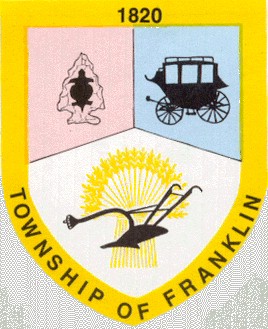SJ History: Franklin Township
 The Township of Franklin takes pride in their ‘Seal,’ which tells the rich history of the Township dating back to the early 1800’s. The upper-left hand corner symbolizes the Indians, who were the first settlers of the township and specifically the Lenni-Lenape tribe. The upper-right hand corner of the shield carries a stagecoach to pay tribute to the transport of early settlers to the area and their contribution to the economy. The lower half of the shield represents the rich agriculture in the area and the farming community.
The Township of Franklin takes pride in their ‘Seal,’ which tells the rich history of the Township dating back to the early 1800’s. The upper-left hand corner symbolizes the Indians, who were the first settlers of the township and specifically the Lenni-Lenape tribe. The upper-right hand corner of the shield carries a stagecoach to pay tribute to the transport of early settlers to the area and their contribution to the economy. The lower half of the shield represents the rich agriculture in the area and the farming community. Franklin Township was created as a municipality in 1820, when parts of Greenwich Township and Woolwich merged to form a new town. The township also encompassed what is now known as the townships of Glassboro, Clayton, Newfield and Elk, but these were created separately by 1924. Franklin Township was then comprised of 55 square miles of an area ripe for farming.
With the water supply coming from the Maurice River and Scotland Run, the township built several gristmills and sawmills. Area streams were widened to become lakes. The custom became for families to accumulate a certain number of acres to be able to pass on to their children. A well-known pioneer named John Porch settled in Franklin Township and built a gristmill and a sawmill on the stream running through his plantation in 1780. The area then became known as Porchtown. He also kept a store at the center of town aside a blacksmith shop, shoe shop and Methodist Episcopal Church in the 1800’s.
Franklinville became one of the earliest settled areas of the township at the beginning of the 19th century. The land was originally owned by William Fisher and was named Little Ease. It was then owned by Meyers Wilson and then Samuel Porch. The pioneer tavern was opened in Little Ease by George Cake and closed in 1880. The establishment was reopened as the Franklinville Inn.
Mr. Edmund Jones began the mercantile business in Franklin Township in 1858. At that time there was also a blacksmith, shoemaker and wheelwright. The second store in Franklinville was owned by Samuel Porch and the third was owned by John F. Nute alongside a railroad station. The station was destroyed in 1880 due to technical difficulties and a new store was built by Thomas Wilson on the opposite side of the railroad tracks. The township also had two churches, one school house, a railroad station and a post office.
Moses Crane settled the portion of the township known as Iona. The locality was originally known as Cranetown but changed to Iona with the opening of the railroad station in the 1860’s. There was a sawmill, stores and a town hall located in Iona.
Christian Stanger purchased the Malaga area in 1813 and built a sawmill to manufacture lumber for the glass works building. There was a pioneer store, wheelwright and blacksmith connected with the glass works. There was also a tavern, a hotel and a railroad depot. Early settlers on the area were Daniel H. Miller and Joshua Richman.
A gristmill was built by John Rosenbaum in 1830 for his own use, but as soon as it was in operation the local people, who, had been pounding their wheat and corn in the old-fashioned mortar, began to patronize the new mill.
In the 1800's there was also a blacksmith, a two-story schoolhouse, and a town hall. Among the pioneers near the center of the township were Robert Chew and Samuel Sharp. Philip Woofford and John Trimnel were also pioneers of this part of the township, which was sometimes called Hopeville, Woolfordtown, and Plainville. In the 1800's there was a Methodist Episcopal Church and a few houses. William Chew and William Surran were prominent settlers of the area known as Pine Hollow, or Chewville, near Dutch Mill. Chewville, in the southeast corner of the township, had a Methodist Episcopal Church and cemetery, steam saw mill and a dozen dwellings.
The area known as New Denmark, about two miles southeast of Franklinville, became known as Janvier in 1843. In the 1800's there was a church, post office, glass house and a rug mill. The Janvier family owned many acres in this area, and someone else was selling worthless deeds to settlers for this property. Miss Mary Fries Janvier replaced the worthless documents with real deeds and did not charge the settlers. According to legend, in appreciation the settlers changed the name of the area to Janvier.
Information collected from the Franklin Township web site FranklinTownship.com.
advertisement

Author: Melissa Samuelson
Archives
Advertise with SouthJersey.com
Shawnee High School
Attractions: N. Pemberton RR Station
New and Improved
Color Me Happy
Collingswood High School
Don't Miss Your Chance to Enter
Kick Off Summer with Unlocking of Ocean
Prof Tells How to Communicate With Kids
And Then There Were Two
New Certificate Prog. at Rutgers-Camden
The Blue Comet Rides Again
R-C Selected as NJ The Big Read Site
Cleopatra Lecture Series at CCC
Surflight Theatre Earns Innovator Award
More...







